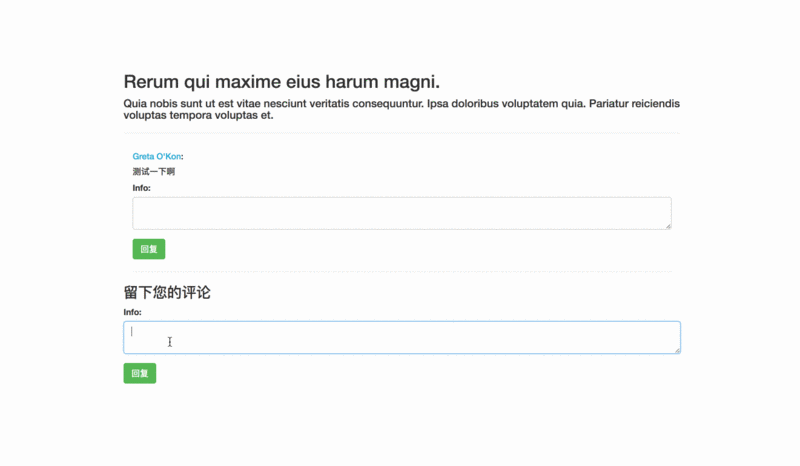ホームページ >PHPフレームワーク >Laravel >Laravel5はネストされたコメントの形式を実装します(詳細なコードの説明)
Laravel5はネストされたコメントの形式を実装します(詳細なコードの説明)
- 不言転載
- 2018-12-21 09:52:143623ブラウズ
この記事の内容は、Laravel5 で実装されているネストされたコメントの形式に関するものです (詳細なコードの説明)。必要な方は参考にしていただければ幸いです。
コメントがさまざまな形式で表示されるのをよく見かけます。たとえば、「@」なんとかなど、Zhihu のような縮小コメント、ネストされたコメントなどです。そのため、最初は次のようになります。最も一般的なのは次のとおりです。
#準備作業
Schema::create('users', function (Blueprint $table) {
$table->increments('id');
$table->string('name');
$table->string('email')->unique();
$table->string('password');
$table->rememberToken();
$table->timestamps();
});posts
Schema::create('posts', function (Blueprint $table) {
$table->increments('id');
$table->string('title');
$table->integer('user_id')->index();
$table->text('content');
$table->timestamps();
});comments
Schema::create('comments', function (Blueprint $table) {
$table->increments('id');
$table->integer('user_id')->index();
$table->integer('post_id')->index();
$table->integer('parent_id')->index()->default(0);
$table->text('body');
$table->timestamps();
});2.モデル層: Post.php ファイル
/**
* 一篇文章有多个评论
* @return \Illuminate\Database\Eloquent\Relations\HasMany
*/
public function comments()
{
return $this->hasMany(Comment::class);
}
/**
* 获取这篇文章的评论以parent_id来分组
* @return static
*/
public function getComments()
{
return $this->comments()->with('owner')->get()->groupBy('parent_id');
}Comments.php ファイル
/**
* 这个评论的所属用户
* @return \Illuminate\Database\Eloquent\Relations\BelongsTo
*/
public function owner()
{
return $this->belongsTo(User::class, 'user_id');
}
/**
* 这个评论的子评论
* @return \Illuminate\Database\Eloquent\Relations\HasMany
*/
public function replies()
{
return $this->hasMany(Comment::class, 'parent_id');
}
ロジックの記述実際に実装したいネストされたコメントには、準備作業でいくつかのアイデアがあり、最初に記事を表示します。すべてのコメントを表示するには、記事とコメントの間の 1 対多の関係を使用します。ただし、このフィールドは、実際には、グループ化を実行するために使用されます。 >comments()->with('owner')->get()->groupBy('parent_id') の具体的なプロセスは次のとおりです:
\Auth::loginUsingId(1); //用户id为1的登录
//显示文章和相应的评论
Route::get('/post/show/{post}', function (\App\Post $post) {
$post->load('comments.owner');
$comments = $post->getComments();
$comments['root'] = $comments[''];
unset($comments['']);
return view('posts.show', compact('post', 'comments'));
});
//用户进行评论
Route::post('post/{post}/comments', function (\App\Post $post) {
$post->comments()->create([
'body' => request('body'),
'user_id' => \Auth::id(),
'parent_id' => request('parent_id', null),
]);
return back();
});
コードを表示ユーザーがお互いにコメントすることが増えるにつれて、ネストのレベルが増えるため、さまざまな方法を使用する必要があります。ここでコメント全体を表示するためのトリックです。 @include() 関数を使用して表示します。この試みの構造は次のとおりです。
- comments comments.blade.php form.blade.php list.blade.php - posts show.blade.phpコードは次のとおりです。 php
nbsp;html>
<meta>
<meta>
<meta>
<link>
<div>
<div>
<h2>{{$post->title}}</h2>
<h4>{{$post->content}}</h4>
<hr>
@include('comments.list',['collections'=>$comments['root']])
<h3>留下您的评论</h3>
@include('comments.form',['parentId'=>$post->id])
</div>
</div>
comment.blade.php
<div>
<h5>
<span>{{$comment->owner->name}}</span>:</h5>
<h5>{{$comment->body}}</h5>
@include('comments.form',['parentId'=>$comment->id])
@if(isset($comments[$comment->id]))
@include('comments.list',['collections'=>$comments[$comment->id]])
@endif
<hr>
</div>
form.blade.php
list.blade.php
@foreach($collections as $comment)
@include('comments.comment',['comment'=>$comment])
@endforeach
最終的なレンダリングは次のとおりです。

以上がLaravel5はネストされたコメントの形式を実装します(詳細なコードの説明)の詳細内容です。詳細については、PHP 中国語 Web サイトの他の関連記事を参照してください。

